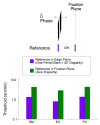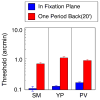Stereo sensitivity depends on stereo matching
- PMID: 16441185
- PMCID: PMC1461459
- DOI: 10.1167/5.10.3
Stereo sensitivity depends on stereo matching
Abstract
Stereoacuity thresholds, measured with bar targets, rise as the absolute disparity of the bars is increased. One explanation for this rise is that, as the bars are moved away from the fixation plane, the stereo system uses coarser mechanisms to encode the bars' disparity; coarse mechanisms are insensitive to small changes in target disparity, resulting in higher thresholds. To test this explanation, we measured stereoacuity with a 6 degrees wide 3 cpd grating presented in a rectangular envelope. We varied the disparity of the grating and its edges (envelope) parametrically from 0 to 20 arcmin (i.e., through one full period). To force observers to make judgments based on carrier disparity, we then varied the interocular phase incrementally from trial-to-trial while keeping edge disparity fixed for a given block of trials. The pedestal phase disparity of the grating necessarily cycles through 360 degrees, back to zero disparity, as the edge disparity increases monotonically from 0 to 20 arcmin. Unlike mechanisms that respond to bars, the mechanism that responds to the interocular phase disparity of the grating should have the same sensitivity at 20 arcmin disparity (360 degrees of phase) as it has at zero disparity. So, if stereoacuity were determined by the most sensitive mechanism, thresholds should oscillate with the pedestal phase disparity. However, these gratings are perceived in depth at the disparity of their edges. If stereoacuity were instead determined by the stereo matching operations that generate perceived depth, thresholds should rise monotonically with increasing edge disparity. We found that the rise in grating thresholds with increasing edge disparity was monotonic and virtually identical to the rise in thresholds observed for bars. Stereoacuity is contingent on stereo matching.
Figures







Similar articles
-
What is the depth of a sinusoidal grating?J Vis. 2004 Jun 29;4(7):524-38. doi: 10.1167/4.7.1. J Vis. 2004. PMID: 15330699
-
Discriminating depth in corrugated stereo surfaces: facilitation by a pedestal is explained by removal of uncertainty.Vision Res. 2008 Sep;48(21):2321-8. doi: 10.1016/j.visres.2008.07.009. Epub 2008 Aug 19. Vision Res. 2008. PMID: 18682260
-
Coarse scales, fine scales, and their interactions in stereo vision.J Vis. 2004 Jun 10;4(6):488-99. doi: 10.1167/4.6.8. J Vis. 2004. PMID: 15330716
-
Variation in stereoacuity: normative description, fixation disparity, and the roles of aging and gender.Invest Ophthalmol Vis Sci. 2003 Feb;44(2):891-900. doi: 10.1167/iovs.02-0361. Invest Ophthalmol Vis Sci. 2003. PMID: 12556426
-
Properties of pupillary responses to dynamic random-dot stereograms.Exp Brain Res. 2006 Jan;168(3):436-40. doi: 10.1007/s00221-005-0180-1. Epub 2005 Dec 2. Exp Brain Res. 2006. PMID: 16323005
Cited by
-
Stereopsis without correspondence.Philos Trans R Soc Lond B Biol Sci. 2023 Jan 30;378(1869):20210449. doi: 10.1098/rstb.2021.0449. Epub 2022 Dec 13. Philos Trans R Soc Lond B Biol Sci. 2023. PMID: 36511401 Free PMC article.
-
The wallpaper illusion explained.J Vis. 2007 Dec 11;7(14):10.1-11. doi: 10.1167/7.14.10. J Vis. 2007. PMID: 18217805 Free PMC article.
-
Absolute and relative disparity mechanisms revealed by an equivalent noise analysis.Sci Rep. 2024 Mar 22;14(1):6863. doi: 10.1038/s41598-024-57406-2. Sci Rep. 2024. PMID: 38514715 Free PMC article.
References
-
- Badcock DR, Schor CM. Depth-increment detection function for individual spatial channels. Journal of the Optical Society of America A. 1985;2:1211–1216. [PubMed] - PubMed
-
- Bredfeldt, C., & Cumming, B. G. (2005). Explaining cyclopean edge selectivity in macaque area V2. Abstract CoSyne Meeting, March, 2005.
Publication types
MeSH terms
Grants and funding
LinkOut - more resources
Full Text Sources
Other Literature Sources

